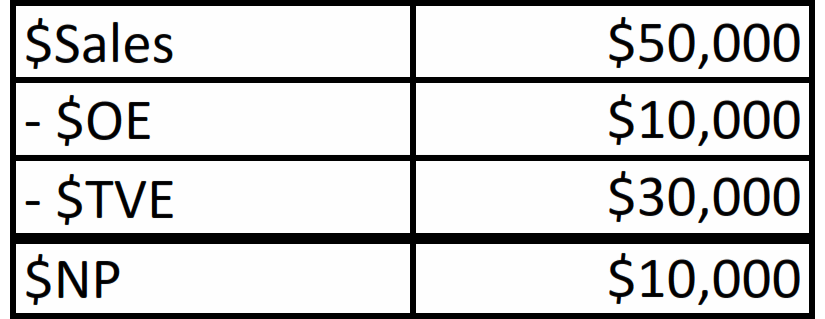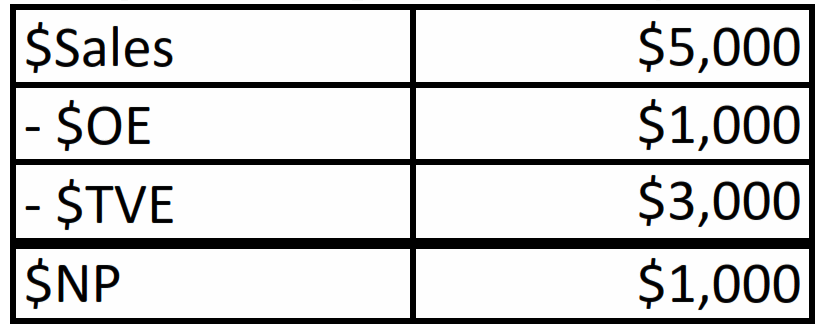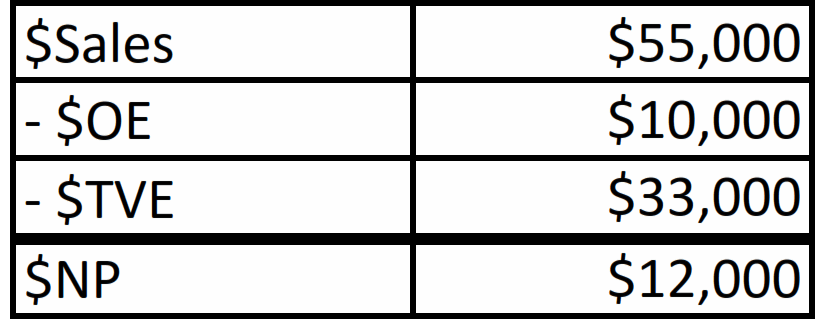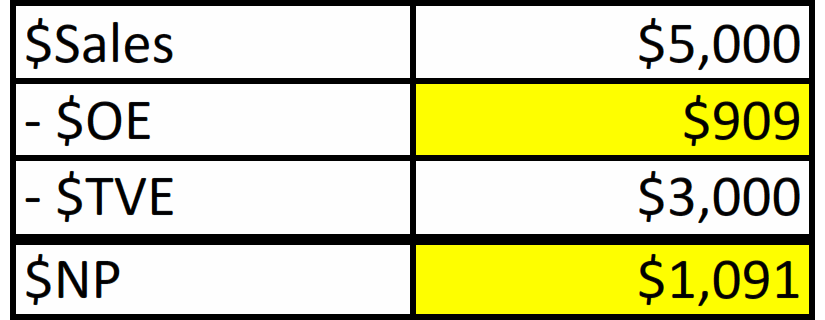Written by Patrick Foley and Kathleen Teodoro for medium.com
Basic Accounting Principles
The main goal of a business is to make money. Obviously. But how do you know when you’re achieving that goal?
You make money by charging your customers more than your overall expenses — the difference between your Sales revenue ($Sales) and your costs (otherwise known as Expenses or $E) is your Net Profit ($NP). So if last year you brought in $1,000,000 in revenue with overall costs of $900,000, then you made $100,000 in profit (1,000,000–900,000). Simple.


To make more money, you can either increase your sales, decrease your expenses, or both.
An Example Countertop Fabricator
At the end of any month, it’s easy to tell if you succeeded. Let’s say you sold 10 kitchens last month for a total of $50,000 in revenue. You have $10,000/month in fixed expenses like rent, equipment payments, salaries, etc. (otherwise known as Operating Expenses or $OE). You also spent $30,000 on things like slabs, commissions, hourly labor, etc. (Truly Variable Expenses or $TVE) to deliver those kitchens, leaving you with $10,000 in profit (and a robust 20% profit margin). It’s common to separate fixed and variable expenses.


You probably already have a report or a spreadsheet that shows you these numbers on a monthly basis. If the numbers keep trending up, it’s confirmation that your business is growing.
Job Costing
But a monthly report inherently looks backwards. What if you want to make more money this month? What do you focus on?
Selling another job is what makes the most impact on your business day-to-day, so instead of looking at your business numbers for the whole month, it would be nice to look at the same numbers on a per-job basis. The goal is to estimate the impact of each additional job on your business as it comes in.
To get per-job averages for the example month described above, simply divide the totals by the number of kitchens. Your average kitchen last month was a $5,000 job that consumed $3,000 in variable expenses, accounted for $1,000 of your fixed expenses and $1,000 of your profits.

This average is useful as a starting point, but it has its limits. What if you sold 11 “typical” kitchens instead of 10?
Your revenue would be $55,000 and your variable expenses $33,000 — but your fixed expenses are still $10,000, so your profit would be $12,000 (and your profit margin would improve to 21.8%).

Clearly selling “one more kitchen” each month causes good things to happen for your business, but it’s a little confusing to see how the averages themselves have changed. If you sold 10 “typical” kitchens, you’d average $1,000 in profit per job. But sell 11 kitchens instead and your average profit increases to $1,091 per job.

Note the change in the average $OE and $NP when you calculate them based on 1/11 of the monthly total instead of 1/10.
As you can see, thinking about profit for an individual job is problematic, because you can’t know what portion of your fixed operating expenses should be allocated to each job until you know how many jobs you have! When you’re looking at an individual job (before or after the sale), it’s far more useful to think about throughput instead of profit.
Basic Throughput Accounting
We learned about throughput accounting from Ed Hill of Synchronous Solutions … Patrick even interviewed him for StoneTalk. (You can find that interview and many more at StoneTalk.org).
Throughput ($T) is calculated by subtracting your Truly Variable Expenses ($TVE) from your sales.

Truly Variable Expenses are the things that you wouldn’t consume (or pay for) if you didn’t make the sale, including raw materials, commissions, outsourcing, etc. It doesn’t include fixed expenses like rent, insurance, salaried labor, etc.
Determining exactly what to include in Truly Variable Expenses ($TVE) vs fixed Operating Expenses ($OE) is actually trickier than it sounds, but here’s one way to look at it: If you shut down your business for a month and didn’t sell or fabricate a single countertop, the amount of money you’d have to pay out anyway (for leases, salaries, etc.) — that money adds up to your $OE. Everything else is part of $TVE and can be calculated (or at least estimated) on a per-job basis.
Now let’s look at those averages again. The typical kitchen is still a $5,000 sale. Truly Variable Expenses are $3,000 per job, which makes Throughput $2,000.

That’s it. Fixed expenses — and therefore profit — are simply ignored when looking at an individual job. Instead, you look at fixed expenses and profit over some period of time (typically, monthly or yearly). You can even use throughput to calculate your profit for a period of time.

Looking at the Impact of One More Sale
Throughput for a single job doesn’t change when you sell another job. In this example, a $2,000-throughput kitchen is a $2,000-throughput kitchen no matter how many you sell.
Again compare a 10-kitchen month to an 11-kitchen month, but this time using throughput. Ten typical kitchens would bring $20,000 in throughput (10 x $2,000), making it easy to calculate your profit.

Eleven typical kitchens would bring $22,000 in throughput (11 x $2,000). See how much cleaner and easier this is?

We can even compare various scenarios in a table, though our example gets a bit exaggerated. After all, it’s not likely that the throughput for each of your jobs is identical — but even if you used separate $T values for each row below (perhaps for your actual jobs, ordered by sales date), the results are still simple and meaningful … and note that $Sales and $TVE aren’t even needed here (in a real planning spreadsheet, I’d probably get rid of the $OE column as well and just reference a single, fixed cell for it).

Throughput makes it easier to evaluate the past and ask questions about the future! With throughput accounting you can ask questions like “what happens if I sell that 11th kitchen?” In this example, the throughput for your 11th kitchen is $2,000, and your profit for the month also increased by $2,000 because you’ve already covered your fixed expenses for the month.
This provides a useful and intuitive way to think about your business: You need a certain amount of throughput each month to cover your fixed operating expenses (this is often called the breakeven point, and it’s exactly the same as your $OE). After that, all additional Throughput will flow to your bottom line as profit for the month.
In this example, if you only sell 4 typical kitchens in a month, you’ll actually lose money, because your throughput ($8,000) is less than your operating expenses ($10,000). If you sell 5 kitchens, you’ll break even ($10,000 in $T, same as $OE). Sell 6 kitchens, and you’ll make $2,000 in profit — the $2,000 in throughput from that 6th kitchen is profit. 7 kitchens, and you’ll make $4,000. 8 kitchens, $6,000. Each additional kitchen you sell will increase your monthly profit by the throughput for that kitchen.
Profit is only true looking backward over a period of time (you typically look at this in your accounting system). Throughput lets you look ahead and focus on the part of your business you can actually impact each day. It doesn’t really make sense to say “we need to make more profit today” but it makes a lot of sense to say “we need to bring in more throughput today.” That’s a good rallying cry in fact.
Comparing the Impact of Different Jobs
Of course, not all your kitchens are typical, and throughput lets you compare the true business impact of different jobs.
Let’s say you sell a big, $25,000 job — but the material is so expensive that your truly variable expenses are $20,000, so your throughput is only $5,000. You also sell 5 “boring” Ubatuba jobs at $5,000 each, and the throughput for each is $2,000 for a total of $10,000 across those 5 jobs.

Throughput helps uncover the true business value of each job. The exotic job and the 5 boring jobs are both worth $25,000 in revenue, but the 5 boring jobs bring in twice as much throughput, collectively. In this situation, it makes good sense to focus on selling more boring jobs or to revisit your pricing structure so you charge more for exotic materials.
Next Steps
To get started with throughput, you can create a simple spreadsheet and pull numbers from your accounting system to calculate averages — but pretty quickly, you’ll find that we’ve been oversimplifying things a bit here.
There’s still a fair amount of guessing and averaging involved to arrive at your truly variable expenses. So throughput is only an estimate when you project forward, because you don’t know exactly how many jobs will require repairs, which slabs are going to break, etc.
Even so, thinking in terms of throughput for each potential sale is a big improvement over thinking in terms of profit. Start with your best guesses for material costs, hourly labor, and other truly variable expenses and refine as you learn more. Even with these guesses, calculating throughput will help you evaluate the real impact of each sale and learn which types of jobs are better for your business.
As you do this, you’ll soon discover that you need more information to make better estimates — perhaps the number of kitchens you fabricate or the amount of square feet. In a future article, we’ll talk about why those numbers are important, how to track them, and how to use them for forecasting and capacity planning.
In the meantime, if you want to learn more about throughput accounting, we strongly recommend reading The Goal by Eli Goldratt. If you want help applying it to your business, consider contacting Ed Hill at Synchronous Solutions.



